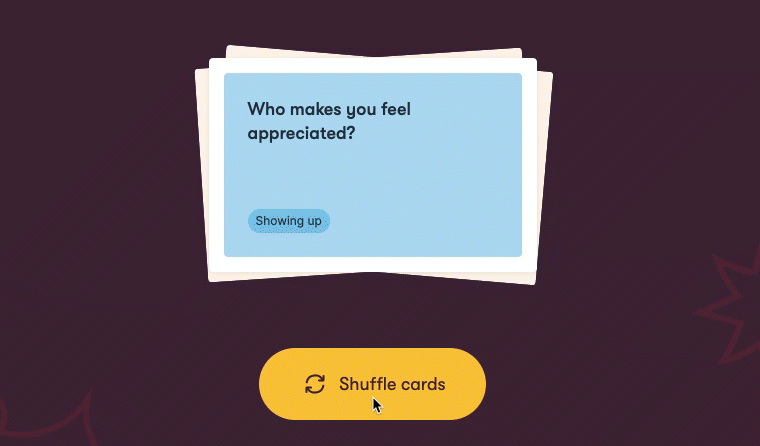Officevibe launched a new recognition feature, and you’ve seen nothing like it before.✨

Leaders worldwide have found cultivating and maintaining a strong company culture one of the most challenging aspects of the pandemic. And now, as we adapt to new ways of working, this pain point is exasperated because teams and people are becoming more dispersed.
Expressing appreciation and giving recognition (lifelines of the employee experience) is more critical than ever. Directly tied to motivation and engagement, they satisfy the universal human need to be seen, heard, and valued. But a remote context means spontaneous social interactions are becoming rarer, leaving fewer opportunities for people to share appreciation and recognition.
Exclusive online summit
·
May 23 2024
Moments that matter: how to seed great work
Why now is the time to rethink your employee recognition program
- Not all forms of recognition are created equal
- Why recognition is important
- Distributed teams crave recognition more than ever
- How recognition software falls short
- Reimagining recognition
- The Officevibe special sauce
- Appreciation is not the same as recognition
- Good Vibes: the recognition engine
- Why you should switch to Good Vibes
Not all forms of recognition are created equal
Our research to better understand the impacts and challenges of distributed work revealed that:
"One of the biggest downfalls of remote work is that workers feel that their emotions, day-to-day work, and accomplishments are far less visible than they used to be in ‘the office days.'”
Officevibe research study on distributed work
Some research participants even confided: “I feel like I only hear from management when something’s wrong. Otherwise, it’s dead silent.”
That tells us that recognition is now more than ever an engagement lever leaders need to pull on to retain the people they've worked so hard to attract.
Kudos Fridays, praise walls, and reward programs are all meant to foster recognition in organizations.
But are all recognition techniques equal? And are they still our best options in this new distributed work environment?
And so, the team of experts at Officevibe took it upon themselves to design a recognition experience that would make your recognition culture actionable, turnkey, and most importantly, habit-forming.
Why recognition is important
Has the Great Resignation hit you? According to Bersin and Associates, highly effective recognition programs can reduce voluntary turnover by 46%. Good recognition initiatives will help keep your employees, increasing their engagement, productivity, and performance.
Our data supports this:
Recognition frequency and Happiness at work are the two engagement sub-metrics with the strongest correlation across all Officevibe engagement metrics.
What does this mean?
Employees who score high on Recognition frequency tend to score high on Happiness at work.
And employee recognition statistics show that employee happiness is a significant player in overall employee satisfaction.
Recognition is one of the top 10 factors of engagement – all of which are intimately linked and connected. You have to put them all together like pieces of a puzzle to get the complete picture of your people's engagement at work.
Julie Jeannotte, HR Expert & Researcher @ Officevibe
Holding the power of so much sway, you would think every organization would prioritize recognition programs. However, knowing something is good for you doesn't mean you'll necessarily do it—or do it often.
Of the 100,000 employees who currently use Officevibe, 34% say that they don’t feel recognized often enough. And the expectations are even set pretty low. A study by Dr. T. Kaufman et al. on the effect of performance recognition on employee engagement indicates that employees only expect to be recognized once a month or even once a year (!)
A lack of recognition has real consequences. Employees who don’t feel recognized are three times more likely to suffer from burnout.
All in all, recognition has a major impact on the wellness of people at work and their overall engagement. A lack of it can exacerbate a climate of negativity, leading to voluntary turnover.
Distributed teams crave recognition even more
In a remote work environment, it’s really easy to drop the little things, like saying hello in the morning without following up immediately with a work-related request. That is the transactional nature of remote work, and it’s killing organizations’ workplace culture.
Employees can quickly feel like their achievements are going unnoticed by management. A colleague recently confessed: “My manager only hears about me when there is something wrong.” We can all relate to this feeling – being engaged by our work yet feeling like our work and its impact are invisible to others.
Our research on the shift to distributed work revealed that remote work accentuates this feeling. The change has caused a severe drop in the quality of our work relationships. Many of us feel like our emotions, work, and contributions are far less visible than before during office days.
Again, it’s no surprise that this is happening more. Spontaneous interactions between team members have declined, and collaboration has become less dynamic.
Microsoft research has found that employee communication networks became static and less interconnected during the pandemic-driven shift to remote work. Yet, collaborative relationships can expand into more creative and meaningful outcomes—a fertile ground for recognition.
So employees want to be recognized, and organizations want a culture of recognition reinforced by the managers. How is this currently being addressed?
How recognition software falls short
There are countless recognition tools, but our analysis clearly shows that the offer is somewhat homogenous and unoriginal. Vendors offer the same features, and you don’t have to dig too deep to realize that they have some fundamental flaws.
Praise walls are for extroverts
Most engagement software supports public and private recognition, often through a Slack integration. Some can be gamified, offer leaderboards and reactions, and connect to your company values.
The problem with praise walls or kudos channels on Slack is that the more successful they are, the more noise they generate. Employees will likely be notified about recognition between coworkers they have never met in larger organizations. As a result, it becomes easy to 'mute' the channel to avoid these distractions. Bye-bye recognition culture!
Recognition overload, however, is rarely an issue. For example, Officevibe’s parent company has a quiet company-wide kudos channel. We’re close to 300 employees focused on improving employee experience, yet we average between two and three posts per month in our Kudos channel. Not exactly what we would call a “strong culture of recognition.”
It could indicate that some employees are uncomfortable with posting/receiving kudos publicly, as we discovered in our research (more below). As a result, they send a message privately, which is positive, but their manager has no visibility into it, and this valuable information gets lost.
When managers have access to peer-to-peer recognition, it allows them to understand their team members' strengths.
Great leaders can leverage these tools to improve the performance of their team or individual contributors by setting targets to fill gaps or identify new opportunities for members to use their strengths in new ways (with a change in role or responsibilities, for example).
Reward programs reinforce transactional interactions
Rewards programs let you receive and send recognition, earning you points that can be redeemed for tangible items like vacation time or a blender. Incentives are a legitimate way to boost participation, but they can also undermine the impact of recognition.
Are peers really appreciating your work or just playing the game?
Using points as currency reinforce transactional interactions, which we want to avoid as much as possible in a distributed context.
Don’t force me to give John a kudo
A new, technologically-enhanced approach is integrating your engagement software with your company’s Outlook. When two employees have met, it prompts them to give each other kudos. As many of us simply don't think of giving recognition, this is a smart solution. The downside is that this can be stressful and also feel forced.
Say you received a message asking you to give Mary, whom you met with last week, kudos. You’ll wonder, “Will she know if I don’t give her one? Did she get prompted to? Why didn’t she send me one?” Or worse, “Did she send me a kudos just because she was asked to?”
It's as if both the host and Airbnb guest could see each other's reviews before writing their own. Would you be 100% genuine?
Our internal experiments revealed that users of such solutions felt the recognition received was unauthentic.
Reimagining recognition
Recognition sits comfortably between employee engagement and performance and is a popular request from our Officevibe clients. Our team wanted its approach to recognition to be different from what was out there. So we ran an innovation challenge focusing on the theme of recognition.
Our innovation challenge
How Good Vibes was born
The entire company was invited to design and test a prototype. Over a few weeks, five teams competed in the challenge. Beyond the inspiring ideas that the project yielded, the most valuable part was the insights generated from testing the solutions.
That’s how we learned that:
- Many employees are not comfortable being recognized publicly
- Recognition can be a way for companies to reinforce their values
- Peer-to-peer recognition should feel authentic and come from the heart
- Participation should be voluntary, not mandatory; otherwise, it feels disingenuous
Ultimately, the more you force people to give recognition, the less they will value it. On the other hand, if nothing is done, recognition won’t come by itself. So what is a product designer to do?
The Officevibe special sauce
Having understood the needs of both employees and organizations, we were able to design an experience that would enable our clients to truly foster a recognition culture.
How might we help employees notice the positive around them and prompt them to recognize their peers?
When nudging users to adopt a new behaviour, designers optimize triggers, user motivation, and/or ability. We knew that our triggers would need to be gentle enough for the recognition to be genuine and that trying to convince employees to give each other praise through rewards was a dead end. The only option left was to make it easy (and fun) for teammates to recognize and appreciate each other.
Reducing effort was the name of the game. In addition, we based our brainstorms on our design principles: simple, human, and memorable. It meant our solution needed to be dead simple and authentic and that it should be as fun to receive recognition as it is to give it. After all, the simplicity and fun of Officevibe’s Pulse Survey have always been our best selling points.
Appreciation is not the same as recognition... but is still nice
Early on, we thought about tying recognition with our performance modules (1-on-1s, team goals, and more) so that employees could celebrate each other for a job well done. This type of recognition works because it’s scarce: only the top achievers get recognized; otherwise, it would be meaningless.
Thankfully, recognition is not only about celebrating outstanding achievements (a formal form of gratitude that flows down the chain of command). It can also be acknowledging, in your own words, your colleagues for who they are. Or for their valuable contribution to the team! This is appreciation, and it is infinite. Even if you were to thank every one of the 3,000 employees in your company, the gesture would still matter.
Recognition is appropriate and necessary when it’s earned and deserved. Appreciation, however, is important all the time.
It would be a huge oversight not to discuss the connection between recognition and your organizational culture and values. When you think about it for a minute, the behaviours your team members get recognized for telling you what matters to them and what makes teamwork work. It’s through behaviours that your culture becomes tangible.
Closely examining what traits and behaviours people receive recognition for will tell you how your values are lived in the daily interactions between your people.
Are they closely aligned with the culture and values you think you share as an organization or is your recognition data telling a different story?
If so, you may need to reconcile the two so that you can proudly say that your team is “walking the talk” in terms of values and culture.
The amazing Brené Brown sums it out with this quote:
"We can’t live into values that we can’t name AND, living into values requires moving from lofty aspirations to specific, observable behaviours."
Brené Brown
Good Vibes: the recognition engine
Our objective: To make it fun and easy to recall and identify behaviours and traits worthy of recognition so that team members can flex their recognition muscles.
We crowdsourced pre-written prompts that jogged positive memories from our team members and managers. We called it “Good Vibes.”
Extroverts and high-achievers often get all the attention. We were more inclusive because we used both recognition and appreciation in our final concept. We created Good Vibes cards that could apply to various personality types like the cheerleader, the wise introvert, the risk-taker, the unsung hero, and many more.
Prompts take the form of cards which can be shuffled until you come across one that makes you think of someone or a positive behaviour they exhibited. It’s just like browsing the Hallmark cards display until you find a card that makes you think of someone. I think the most important aspect of this design is that it's simple (no anxiety over the blank page) and evokes only positive situations for the user.

Employees won’t adopt a recognition culture if it’s not fun, so we put extra care into creating a delightful receiving experience: it feels just like unwrapping a gift. Did you say confetti? 🎉
With an existing habit already ingrained in our users’ routine (to respond to their five-question weekly Pulse Survey), we identified it as THE moment to trigger recognition. And so, team members will occasionally encounter Good Vibes after completing the Pulse Survey.
This trigger has the potential to create a wave of peer recognition, and the frequency is our best bet in building the recognition muscle. Just like our famous, often imitated yet never duplicated Pulse Survey questions, Officevibe customers will be able to benefit from our expertise in selecting traits and behaviours that are worth praising. Our internal HR experts contributed and reviewed the collection to ensure high quality and inclusivity.
"Recognition is… not only knowing that one's work matters but feeling it. It deepens our connection to our colleagues and our whole work ecosystem. It many times incites us in turn to recognize others. Not too bad of a way to fuel an abundance mindset. ;)"
Kahina Ouerdane, Chief People Officer
Where is the manager in all this?
Recognition between peers is visible between the recipient and sender and their team's managers. People's good deeds won't be invisible anymore, and we can close the recognition loop. And another reason why Officevibe should be used in preference to Slack, or at least in addition to Slack.
Good Vibes offers teams the opportunity to connect on a deeper level, building communication habits that are frequent, valuable, and meaningful.
Why you should switch to Good Vibes
We believe that recognition works within a holistic management approach.
Good Vibes helps teams:
- Build participation and engagement
- Become more inclusive
- Develop good communication practices
- Make recognition more meaningful and genuine
- Express clearly what your company values
Our vision is to help employees recognize the behaviors valued by organizations so that the culture can be reinforced organically through its people.
Personally, I am grateful to have had the chance to work on something that can improve the lives of thousands of people trying to adapt to their new remote work reality.



